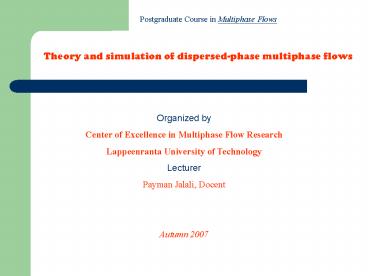Theory and simulation of dispersedphase multiphase flows - PowerPoint PPT Presentation
1 / 18
Title:
Theory and simulation of dispersedphase multiphase flows
Description:
... velocity can be divided into two parts: virtual mass effect and the Basset force. ... Basset force. Particle-Fluid Interaction. Turbulence effects ... – PowerPoint PPT presentation
Number of Views:99
Avg rating:3.0/5.0
Title: Theory and simulation of dispersedphase multiphase flows
1
Postgraduate Course in Multiphase Flows
Theory and simulation of dispersed-phase
multiphase flows
Organized by Center of Excellence in Multiphase
Flow Research Lappeenranta University of
Technology Lecturer Payman Jalali,
Docent Autumn 2007
2
Particle-Fluid Interaction
Momentum transfer - Steady-state drag forces -
Stokes drag law, Faxen force
3
Particle-Fluid Interaction
Pressure gradient and buoyancy force
Particle clouds
Unsteady forces The forces due to acceleration
of the relative velocity can be divided into two
parts virtual mass effect and the Basset force.
Virtual or apparent mass effect
Basset force
4
Particle-Fluid Interaction
- Turbulence effects
- Two parameters are used to quantify the effect of
carrier phase turbulence on the particle drag - the relative turbulence intensity
- the turbulence length scale-particle diameter
ratio - The relative turbulence intensity is
5
Particle-Fluid Interaction
6
Particle-Fluid Interaction
7
Particle-Fluid Interaction
Nonspherical particles The degree of
nonsphericity of particles is quantified by the
shape factor
K2func(?,Re)
8
Particle-Fluid Interaction
9
Particle-Fluid Interaction
Example Find the drag force on a 1-mm cubical
particle in an air stream at standard conditions
with a relative velocity of 1 m/s. First, we
calculate the shape factor.
The Reynolds number of the equivalent sphere is
The effective drag factor from the given figure
is 60, so the drag force will be
10
Particle-Fluid Interaction
Lift forces Lift forces are due to particle
rotation. This rotation may be caused by a
velocity gradient or may be imposed from some
other source such as particle contact and rebound
from a surface. Saffman lift force It is due to
the pressure distribution developed on a particle
as a result of rotation induced by a velocity
gradient.
Saffman (1965,1968) analyzed this force for low
Reynolds numbers and found the magnitude of the
force to be
11
Particle-Fluid Interaction
The Saffman force can also be written in the form
of
Bothe Reynolds numbers must be much less than
unity. There are empirical correlations such as
Mei (1992) for higher Reynolds numbers.
12
Particle-Fluid Interaction
Magnus lift force It is due to the rotation of
the particle for the reasons except the velocity
gradient. Translational relative velocity at the
surface of particle differs from point to point
due to rotation. The lift force was derived by
Rubinow and Keller (1961) for Reynolds numbers in
the order of unity
13
Particle-Fluid Interaction
A lift coefficient can be defined
where A is the projected area of the particle,
CLR is the lift coefficient due to rotation and
?r is the relative spin of the particle with
respect to the fluid
14
Continuous phase equations
- The ideal analysis for dispersed phase flows
would be to solve the governing conservation
equations for the carrier phase by accounting for
the boundary conditions imposed by each and every
particle or droplet in the field. This would
provide a complete description of the carrier
phase throughout the mixture. - This is computationally a difficult task as we
will need a grid dimension as small as the
smallest particle in the field. In low Re, there
have been different analytical or numerical
solutions. However, in general, one must consider
using equations based on the average properties
in a flow. - Here, we will introduce the averaging procedures
as well as the equations in volume average form
suitable for numerical model development. - Averaging approaches - Effects of particles or
droplets on boundaries - Conservation equations for quasi-one-dimensional
flow are developed - More general multidimensional equations based on
volume averaging
15
Continuous phase equations
Averaging procedures Basically, there are 3 ways
of averaging time, volume, and ensemble
averaging. -Time averaging It is the result of
averaging the flow properties over time at a
point in the flow (hot-wire or laser-Doppler
anemometry). The averaging time must be large
compared to the local fluctuation time.
- Volume averaging It is carried out by
averaging properties at an instant in time over a
volume and ascribing the average value to a point
in the flow. The averaging volume must be much
larger than the molecular distance cube and much
smaller than the container volume
16
Continuous phase equations
Phase average is the average over the volume
occupied by a phase
- Ensemble averaging
- It avoids the shortcomings of time and volume
averaging but it is much more difficult to
implement. It is based on the probability of the
flow field being in a particular configuration at
a given time. For example, if the density is
measured many times over a region and found that
there are N different configurations (realization
or ensemble), and for a realization ? at a given
time t we have the distribution function
17
Continuous phase equations
Assume that this ensemble has occurred n(?)
times. The ensemble average is then
In the limit where we have infinite realizations,
we have
In other words, ensemble averaging considers all
statistical variation of data in space and time
for calculating the average values.
18
Practice
If a particle loosing its mass nonuniformly, the
translational momentum equation will be
where the efflux velocity can be considered in
the direction of normal vector and

